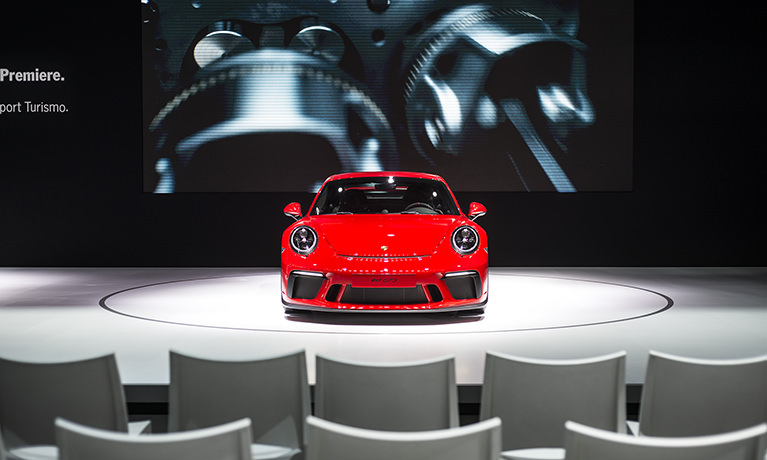
One hundred and seventeen years after the New York International Auto Show (NYIAS) debuted, it still carries the same momentum in the automotive world, but today the differences lie in the concepts being exhibited to the masses.
Today, auto manufacturers are looking to provide alternative fuel sources and take care of the environment, instead of pushing the boundaries of visual design as they have in the past. The delightful supercars of the world are now unveiled in motorsport-adoring countries in Europe, while Americans at the Jacob K. Javits Convention Center in New York are fed a spoonful of what is now thought to be critical to the success of their market – electric vehicles.

I arrived to the show on the morning of Media Day, a privilege that has its perks at NYIAS. Compared to a general admission day and being crammed into the Auto Show with the majority of New York’s automotive community, there are far fewer people on Media Day, which gave me particular freedom to view the exhibits without the cumbersome task of dodging showgoers.
Let’s backtrack a little to explain my plan for my morning arrival. I wanted to see Honda unveil their car, scheduled for 11AM. I live forty-five minutes from the Hamilton, New Jersey train station, which runs Express trains capable of getting me from Hamilton into Manhattan in just an hour and fifteen minutes. So I rushed around to get to the train station to make the 9:08AM train, this would give me plenty of time to walk the several blocks toward the Hudson River from Penn Station, to arrive at the convention center before 11AM. Except it was a 9:03AM train, which was leaving the station as I walked onto the platform. I would have to wait twenty more minutes for the next train, which ended up being the Local train which took far longer to get to the city, so I waited eight more minutes for the next Express train.
Once off the train, I knew I only had fifteen minutes to walk from Penn Station to the Javits Center, get my credentials validated, enter the event, and find the Honda booth. I was particularly excited to see what kind of setup awaited me at Honda, as they planned to officially release the production model of the first Type R badged Honda on United States soil – the Civic Type R.

I entered the show, snaked through the maze of automotive booths and rushed to find the Honda booth. As I arrived, someone speaking with a microphone attached awkwardly to their tie was broadcast on a giant television screen, greeting dozens of media professionals all eager to see the latest unveiling.
It was then I glimpsed something out of the corner of my eye…



The mental 306-horsepower-equipped Civic Type R sitting alone, and unwanted on the normal floor of the Honda booth, surrounded by the full fleet of Civic models available for purchase next year. People looking past it at the giant stage occupied all open space while the presentation for Honda’s newest car concluded.
But what could they be unveiling if the illustrious Civic Type R was left with the average cars?

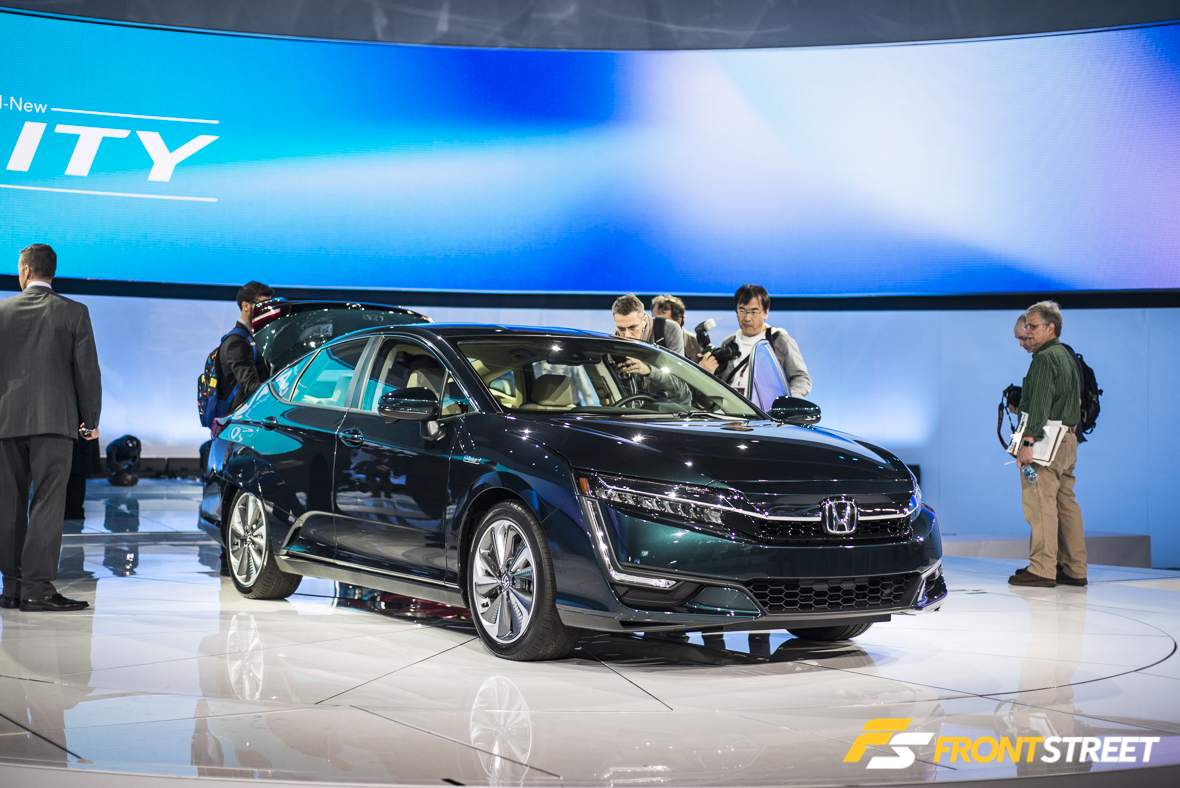

It was Honda’s foray into the next generation of vehicle: the Honda Clarity, a family sedan available in three different drivetrain types; a zero-emissions hydrogen fuel cell version, a plug-in hybrid, and a full-electric model. This was what I stressed over all morning? An electric car that only gets 80 miles per charge? Where were the strobe lights, the confetti cannons, and the deep, ominous voice announcing the introduction of “Honda’s newest hot hatchback, the Civic Type R”? The lacking presence of these ingredients was my first clue of what the rest of the event would feature; I just didn’t know it at that moment.


I skipped around from manufacturer to manufacturer and retraced my steps to the entrance of the convention center, where I found Ford’s booth overflowing with common vehicles to appeal to the masses. Tucked away in the far reaches of their display was the $70,000 Shelby GT350R Mustang dressed in blue with black/red racing stripes. The existence of its 526-horsepower 5.2-liter V8 helped me feel a little better about what I might see throughout the day.



Not to be outdone, Chevrolet positioned their new 2018 Camaro ZL1 1LE at the forefront of their exhibit, as a reminder that they, too, can build an incredibly-capable racetrack-proven muscle car. With factory components like special carbon fiber aero bits and an adjustable suspension, this model can push its way around General Motors’ test course three whole seconds faster than the standard ZL1 Camaro. That’s quite the improvement to what is already a very solid platform.


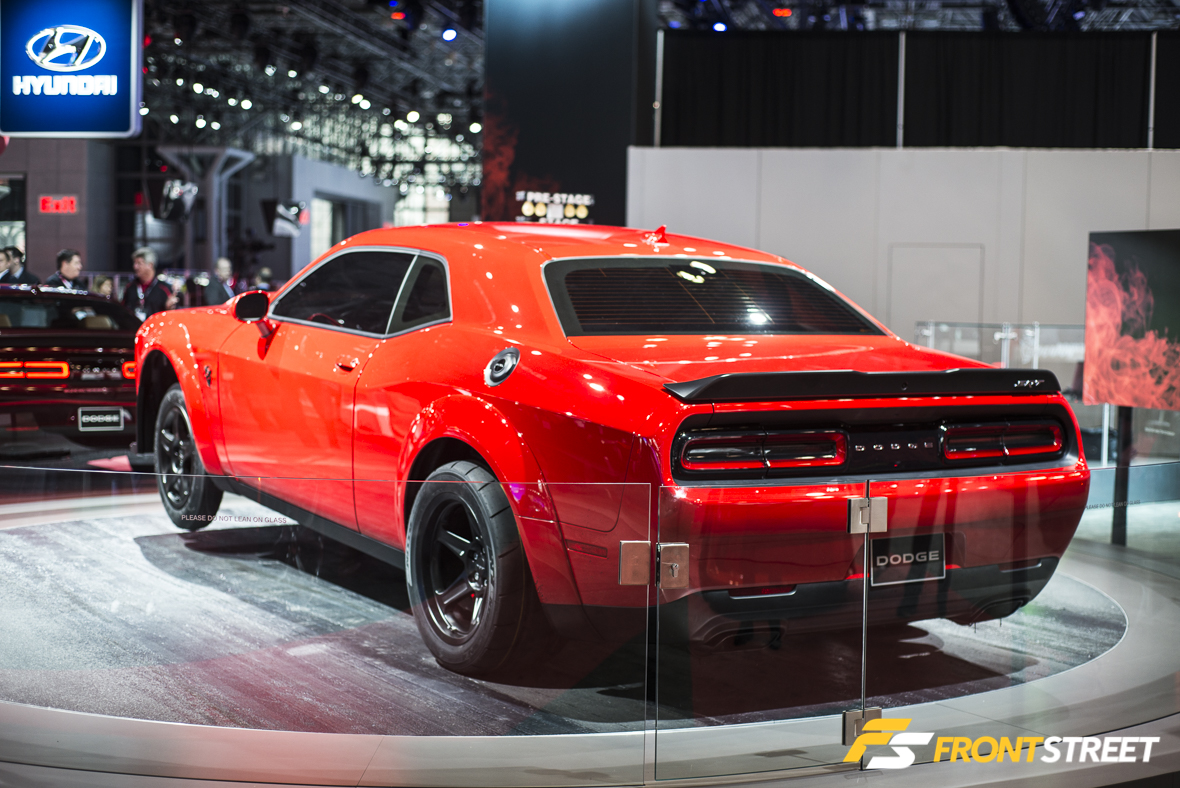
However, both of those muscle cars would need to form like Voltron in order to compete with the newest contender from Dodge – the brain-melting 840-horsepower supercharged Challenger SRT Demon. Actually, this car is in a class of its own, regardless of body type. Dodge went above and beyond while creating this car by setting out to not only provide class-leading horsepower numbers and 0-60 test records, but to obliterate these data points with respect to the competition from Chevy and Ford. In the process, the insane team at Dodge has created the fastest street-legal factory-built muscle car in existence. Equipped with drag radial tires, a line-lock to simplify the burnout process, and efficient suspension components from the factory, this car wheelies off the line and treks a quarter-mile in just 9.6-seconds. For an out-of-market reference to performance scale, a 6.5-liter V12-engined 2016 Lamborghini Aventador LP750-4 Superveloce takes 10.7-seconds to journey the same distance, and costs almost five times the price. Let that sink in for a second and picture the stereotypical traffic light scenario. It’d be tough to wipe the grin off the Dodge owner’s face, and that is a success in itself.



Moving back to the pedestrian side of the show, Volkswagen showcased several variations of new Golf models, under their same “Think New” tagline as previous years. One particular version of the iconic hatchback was highlighted on their stage, the new 100% electric e-Golf. Since it doesn’t use a conventional internal combustion engine, the e-Golf should help Volkswagen evade any more controversy on dodging emissions regulations.



While Porsche unveiled a new Panamera Turbo S E-Hybrid fitting in with the eco-friendly competition, the latest 911 was front and center in Porsche’s display to appeal to their traditional buyer – the motorsports enthusiast. Now producing 500-horsepower from the same high-revving 4.0-liter flat-six variant found in their 911 GT3 R and 911 RSR racecars, the new 911 GT3 brings motorsports-inspired street cars back to purity. Responding to the hole in the market for unadulterated automotive joy, the engine is naturally aspirated and revs higher than before to provide an exquisite aural experience, while the available manual transmission ensures the traditional Porsche experience.
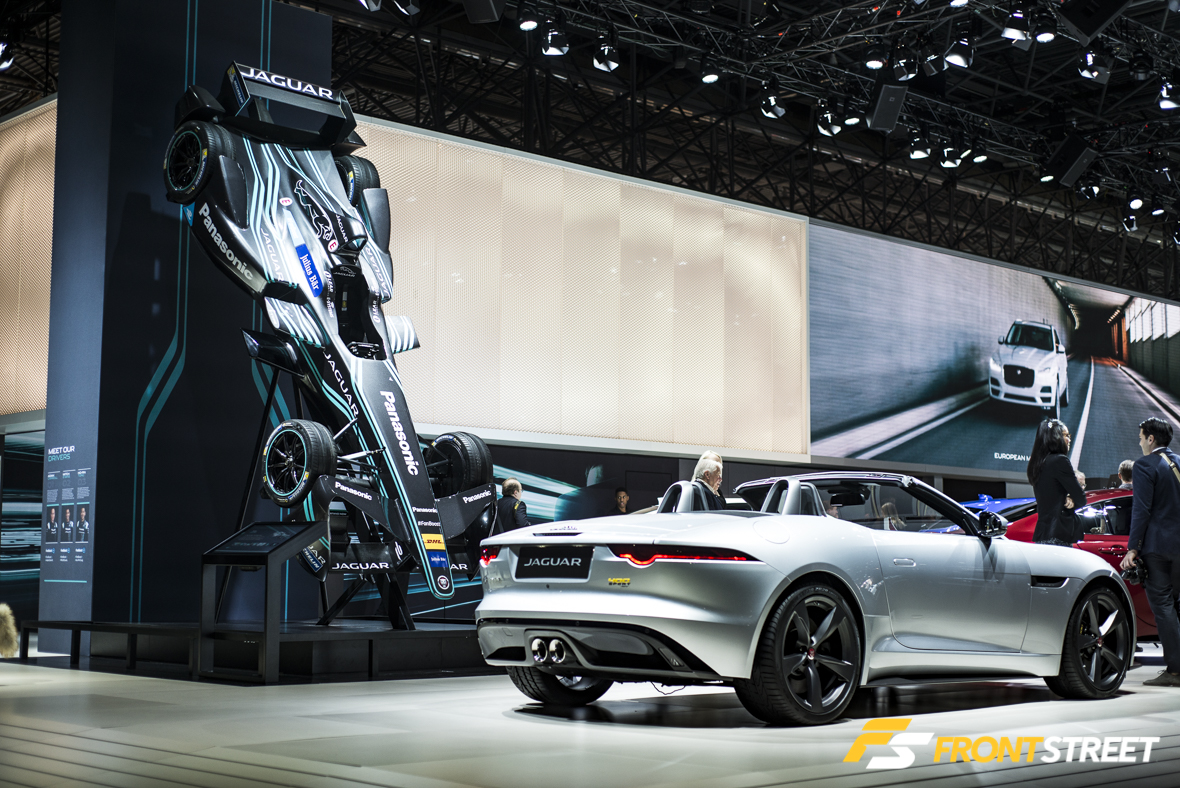
Even Jaguar got in on the electric-vehicle buzz, erecting their open-wheel electric racecar from the Formula E championship vertically atop their display. Looking down onto their 400-horsepower 3.0-liter supercharged F-Type 400 Sport model, the information gleaned from the performance of the Formula E car will surely transfer into production of electric technology for their road cars in the future. Perfect timing too, with the inaugural New York ePrix happening in July on the Brooklyn docks.



BMW’s three-part display split their guests into separate destinations. The M corner ominously showcased the motorsports-oriented aspect of their vehicle lineup surrounded by black walls, with the legendary PTG E36 overlooking the new models from the penthouse.
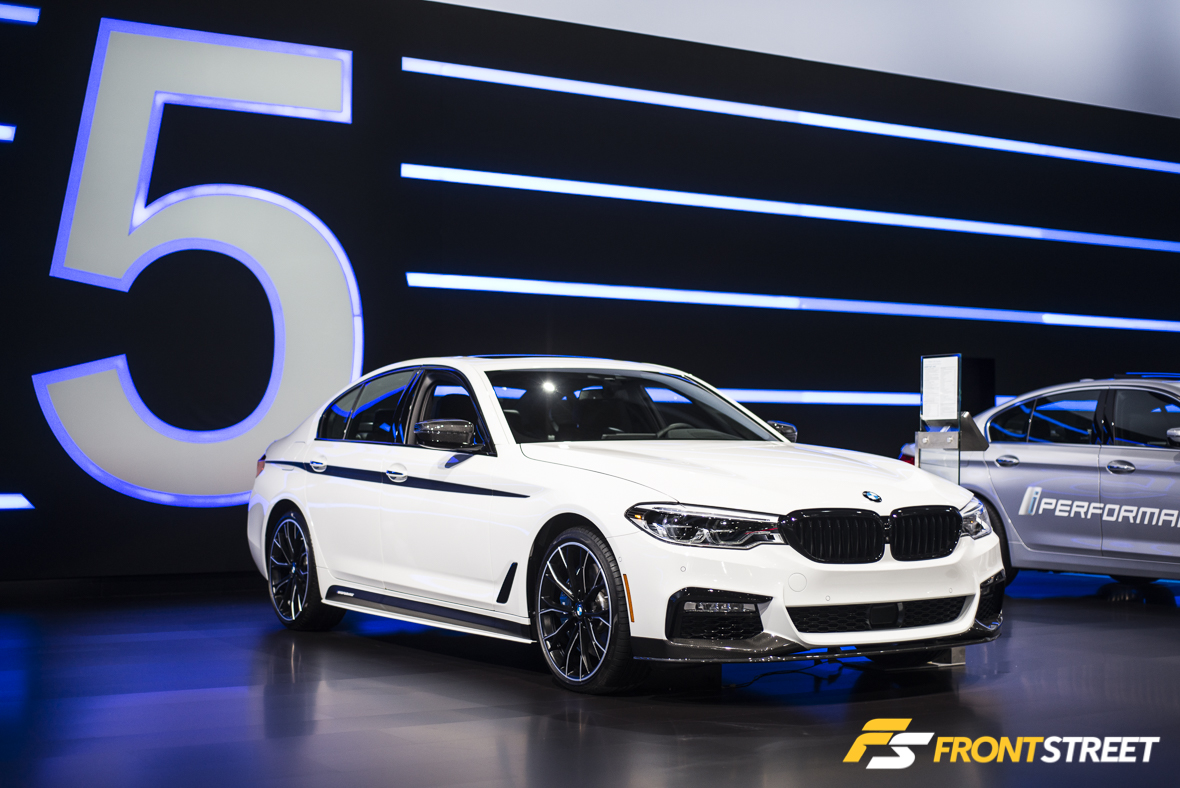

The center of the display was dedicated to unleashing the new BMW 5-series out into the world, with an M-Performance-equipped 540i under the lights as the main attraction beneath a massive illuminated number five.

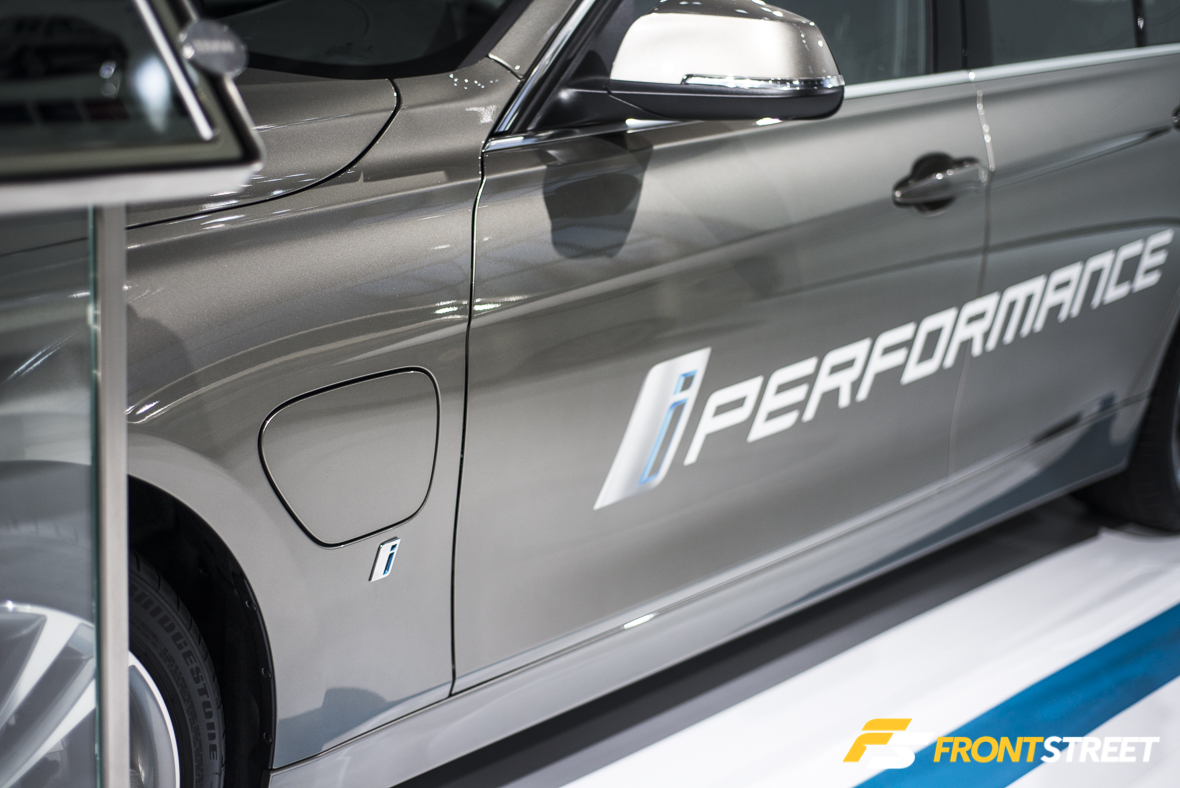

Opposite to the M corner, was their iPerformance section, where eco-conscious admirers of the Bavarian marque can get their green on. This section was filled with various sedans and SUVs powered by hybrid powerplants, including their not-so-fast but eco-friendly sportscar the i8, clad in its Formula E pace car garb. This will also be at the Brooklyn docks in July for the ePrix.



Lexus took a different approach to the electric-car craze of this year’s show with the “IS LIT”, by mounting 41,999 LED bulbs across the expanse of an IS sedan’s flanks. The car’s LEDs are programmed to illuminate an ever-changing flow of different designs for a mesmerizing display of brightness that’s sure to catch the eye of any onlooker. Unfortunately, this is not a production vehicle, so don’t look for any Lexus-badged orbs of light broadcasting YouTube fails to be circulating the street anytime soon.



I half-expected to stumble onto some form of an electric or plug-in R8 sportscar in Audi’s section, but I was instead treated to the visual delight of a track-ready racecar equipped for GT4 racing. While GT3 racing is compiled of works teams from the world’s leading automotive manufacturers, GT4 racing takes an entry-level privateer approach with homologated racecars based more closely upon the production version of the vehicle. This R8 LMS GT4 will directly compete with the Porsche Cayman GT4 Clubsport and other models from Chevy and McLaren. While pricing hasn’t been announced, it will be cheaper than the $450,000 R8 LMS GT3, which is not too bad for an entry into the overwhelmingly high-priced world of professional level racing.
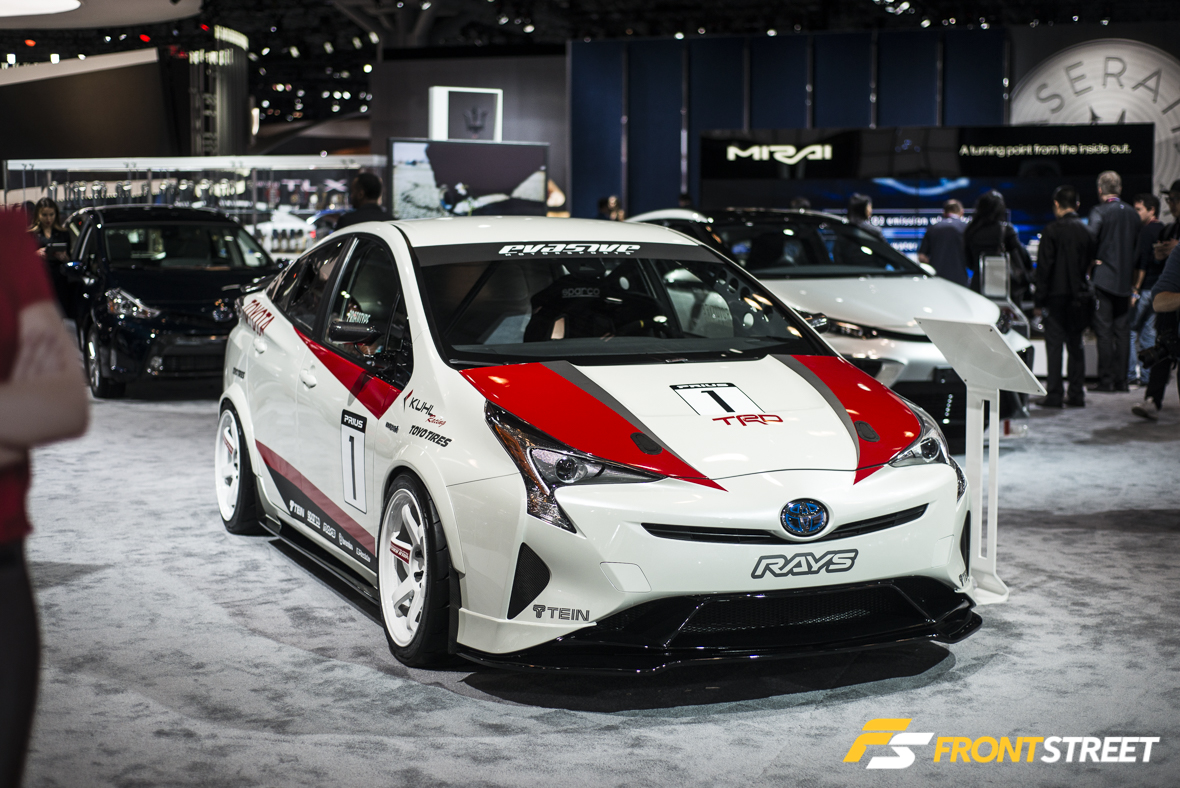

A refreshing take on the Toyota Prius – the world’s most prominent hybrid vehicle – built by the collective minds at Evasive Motorsport and Toyota Racing awaited attendees in the Toyota portion of the show. Modeled after the aggressive styling featured in the Super GT racing series, this Prius wears exterior pieces from Kuhl Racing and Voltex, while Volk TE37 wheels complete the appearance of a purpose-built racecar. The interior (or lack thereof) houses an elaborate roll cage, racing seat, and racing harness, along with a pair of induction hoses feeding fresh air to the rear brakes via ducting on the outside of the car. This was a clear favorite of mine, and although I was able to see this car at SEMA last November, it was nice to have the ability to view it free from the anarchy of the SEMA show.



Finishing off my day was a trip to the lower floor of the event, where industry-leading wheel manufacturer RAYS Wheels utilized valuable floor space to showcase their new wheel models, both individually and also featured on a select group of worthy vehicles. This year, that assortment included an RE-Amemiya Mazda RX7 with Gram Lights 57Transcend wheels, an ND5RC MX-5 Miata with Volk Racing TE37V wheels, a Subaru STi with Gram Lights 57CR wheels, and a Mitsubishi Lancer Evolution, also with Volk Racing TE37V wheels.
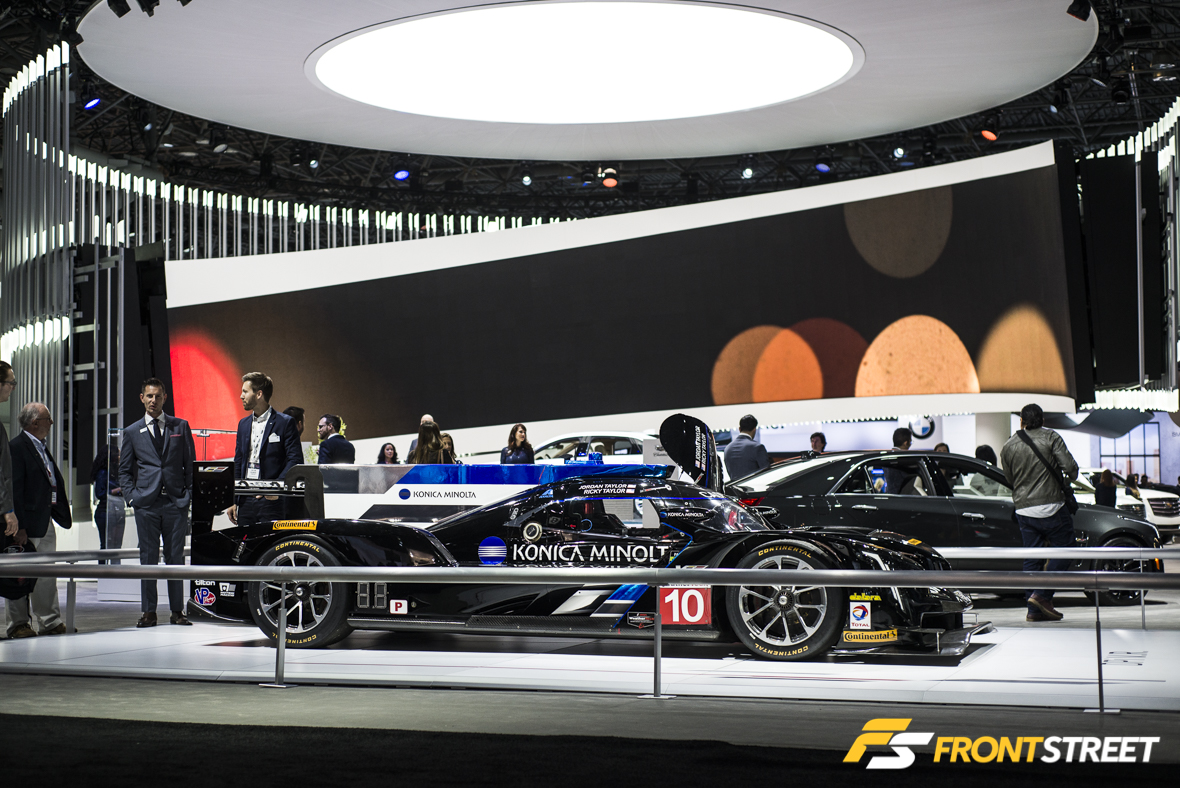
I packed up my camera, walked down The High Line to Chelsea Market, thus completing my tourist duties while in New York, and then hopped the train home. I thought about how heavily electrically-influenced the auto show was this year, and while the majority of manufacturers are pushing toward this new breed of eco-friendly vehicles, there are still many creating petroleum-based automotive treasures for us enthusiast consumers. That’s enough to keep me going.













































